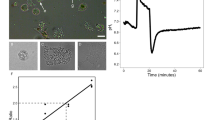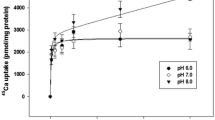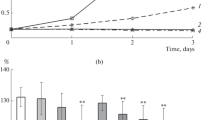Abstract.
We have used current/voltage (I/V) analysis to investigate the role played by extracellular mucilage in the cellular response to osmotic shock in Lamprothamnium papulosum. Cells lacking extracellular mucilage originated in a brackish environment (1/3 seawater). These were compared, first with cells coated with thick (∼50 μm) extracellular mucilage, collected from a marine lake, and second, with equivalent mucilaginous marine cells, treated with heparinase enzyme to disrupt the mucilage layer. Histochemical stains Toluidine Blue and Alcian Blue at low pH identified the major component of the extracellular mucilage as sulfated polysaccharides. Treating mucilage with heparinase removed the capacity for staining with cationic dyes at low pH, although the mucilage was not removed, and remained as a substantial unstirred layer. Cells lacking mucilage responded to hypotonic shock with depolarization (by ∼95 mV), cessation of cyclosis, due to transient opening of Ca2+ channels, and opening of Ca2+-activated Cl− channels and K+ channels. Cell conductance transiently increased tenfold, but after 60 min was restored to the conductance prior to hypotonic shock. Mucilaginous cells depolarized by a small amount (∼18 mV), but Ca2+ channels failed to open in large enough numbers for cyclosis to cease. Likewise most Ca2+-activated Cl− channels failed to open and conductance increased only ∼1.2-fold above the prehypotonic level. After 60 min conductance was less than the conductance prior to hypotonic shock. Heparinased mucilaginous cells recovered several aspects of the hypotonic response in cells lacking mucilage. These cells depolarized (by ∼103 mV); cyclosis ceased, indicating that Ca2+ channels had opened, and conductance increased to ∼4 times the value prior to hypotonic shock, indicating that Ca2+-activated Cl− channels opened. However, after 60 min, these cells had neither restored membrane potential (and remained at positive values), nor decreased their conductance. It was not possible to determine whether K+ channels had opened. The heparinased cells recovered the normal hypotonic response of mucilaginous cells when heparinase was washed out. Apical seawater cells, which lacked mucilage, were unaffected by heparinase treatment. The results demonstrate that the presence of extracellular sulfated polysaccharide mucilage impacts upon the electrophysiology of the response to osmotic shock in Lamprothamnium cells. The role of such sulfated mucilages in marine algae and animal cells is compared and discussed.
Similar content being viewed by others
Author information
Authors and Affiliations
Additional information
Received: 24 March 1998/Revised: 28 April 1999
Rights and permissions
About this article
Cite this article
Shepherd, V., Beilby, M. The Effect of an Extracellular Mucilage on the Response to Osmotic Shock in the Charophyte Alga Lamprothamnium papulosum . J. Membrane Biol. 170, 229–242 (1999). https://doi.org/10.1007/s002329900552
Issue Date:
DOI: https://doi.org/10.1007/s002329900552




